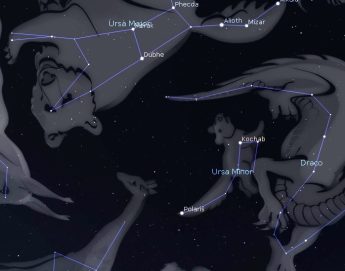This Week’s Sky at a Glance, 2024 May 11 – May 18
This Week’s Sky at a Glance, 2024 May 11 – May 18
The most important constellation of the northern hemisphere for the past millennium has been Ursa Minor, the Little Bear, which is also known as the Little Dipper although it more resembles a ladle. It is important because the fairly bright star at the end of the bear’s tail or the dipper’s handle is Polaris, the North Star. Mariners would determine their latitude by measuring how many degrees of arc Polaris was above the ocean.
Around 10 pm this week the Big Dipper hangs upside-down high in the northern sky. The two stars at the end of the bowl were known as The Pointers because they point (downward in this position) toward Polaris. Two slightly dimmer stars to the right, which are known as the Guardians of the Pole, form the bottom of the Little Dipper, and four much dimmer stars fill out the rest of the bowl and handle. As night progresses you can watch the stars of both dippers circle Polaris counter-clockwise. Years ago the Little Dipper was used as a clock at night, which required knowing its orientation after sunset at different times of the year.
Polaris was commonly thought to be the brightest star in the night sky but it barely makes the top 50. Also, it hasn’t always been the North Star. Earth wobbles like a top every 25,800 years, so celestial north changes over that period. Thuban, a star in Draco between the bowl of the Little Dipper and the handle of the Big Dipper, was the North Star 5000 years ago when the pyramids were being built. Vega will have the honour in 12,000 years, but it won’t be as close to celestial north as Polaris is now.
This Week in the Solar System
Saturday’s sunrise is at 5:58 and sunset will occur at 8:43, giving 14 hours, 45 minutes of daylight. Next Saturday the Sun will rise at 5:50 and set at 8:51, giving 15 hours, 1 minute of daylight.
The Moon is near Pollux in Gemini on Sunday and it is at first quarter on Wednesday. Saturn rises more than two hours before sunrise this weekend, while Mars beats the Sun by an hour and a half. Mercury rises 45 minutes before sunrise all week and continues to brighten, making this a good week to spot it with binoculars during a difficult apparition. Jupiter and Venus are too close to the Sun to observe. Astronomy week begins on Monday with Uranus in solar conjunction, and International Astronomy Day is next Saturday with Jupiter in conjunction. Both are unrelated coincidences.
The Fredericton Astronomy Club meets in the UNB Forestry-Geology building on Tuesday at 7 pm. On Sunday evening at 8 pm, tune in to the Sunday Night Astronomy Show via the Facebook page or YouTube channel of Astronomy by the Bay.

